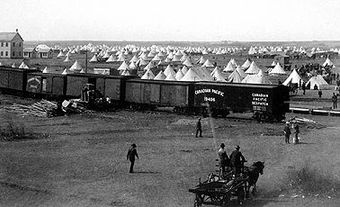The Overlanders of 1862 were a group of some 150 settlers who travelled from Fort Garry (now Winnipeg, Manitoba) to the interior of British Columbia, following the Cariboo Gold Rush. They were led by Thomas McMicking of Stamford Township, Welland County, Canada West [Ontario].

In 1862, groups of men from Canada West, Canada East, the United States, the United Kingdom and Australia travelled by ship and American railway to Fort Garry (Winnipeg). Lured by news of rich gold finds in the Cariboo (see Cariboo Gold Rush), they planned to travel overland to British Columbia. In Fort Garry, they formed a single party of approximately 150 people and chose Thomas McMicking as their leader. The group included Augustus and Catherine Schubert and their three children.
Did you know?
Catherine O’Hare Schubert was the only woman Overlander. By the time the group left Fort Garry in June 1862, she had already travelled a great distance. Born in Ireland in 1835, she immigrated to North America as a teenager. Catherine worked as a maid in Massachusetts and married German immigrant Augustus Schubert in 1855. The two eventually settled in St. Boniface but lost their home and farm in a flood in 1861. When the Overlanders arrived in Fort Garry, the Schuberts decided to join them. Catherine was pregnant on the journey and gave birth to her fourth child in Kamloops, British Columbia.

Catherine O’Hare Schubert was the first European woman to travel overland from Fort Garry (now Winnipeg, Manitoba) to Kamloops, British Columbia.
(Courtesy Royal BC Museum, BC Archives /A-03081/virtualmuseum.ca)
The party left Fort Garry in early June 1862, equipped with Red River carts and a few horses. They reached Fort Edmonton on 21 July 1862 and traded their carts for pack horses. Some members of the party decided to stay. The others hired André Cardinal, a Métis guide, for the difficult journey through Yellowhead Pass in the Rocky Mountains to Tête Jaune Cache on the Fraser River. The Overlanders forded icy rivers and crawled along narrow mountain passes. By the time they reached Tête Jaune Cache, the party was nearly starving. They were saved by a band of Secwepemc (see Interior Salish), who gave them provisions.

“Crossing the Pembina River.” Sketch by artist William George Richardson Hind, August 1862.
(Sketch by WGR Hind, courtesy Library and Archives Canada, Acc. No. 1963-97-1.85R)
The party split on 1 September 1862. A small group, including the Schubert family, decided to raft down the Thomson River to Kamloops. McMicking and the rest of the party rafted down the Fraser River to Fort George (Prince George). All but six of the original group survived. Some went on to the Cariboo goldfields, but found that the gold deposits were nearly exhausted. Many, including Thomas McMicking and his brother Robert, had successful careers in British Columbia.
Did you know?
Artist William George Richardson Hind also travelled with the Overlanders. He recorded the party fording streams, hunting buffalo and passing the time while in camp. Hind later produced a series of paintings of the journey and life in the west, including mining in the Cariboo.

“Tales Over the Camp Fire.” Sketch by artist William George Richardson Hind, July 1862.
(Sketch by WGR Hind, courtesy Library and Archives Canada, Acc. No. 1963-97-1.40R)

 Share on Facebook
Share on Facebook Share on X
Share on X Share by Email
Share by Email Share on Google Classroom
Share on Google Classroom
